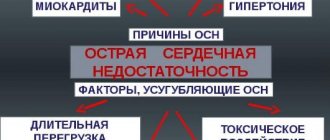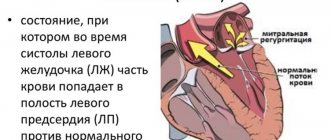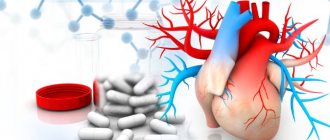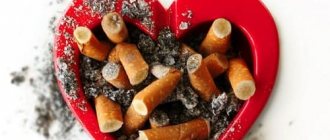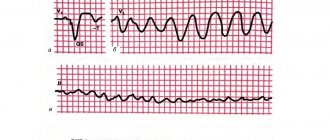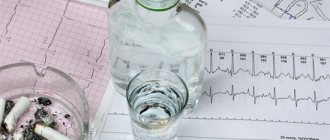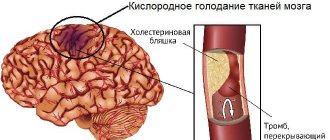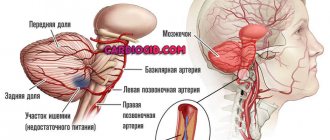Sudden death due to heart failure can overtake a person anywhere and in any condition. But it is not always sudden; in most cases there are certain warning signs that you should pay attention to.
Diseases of the cardiovascular system are very dangerous, since their manifestations are often minor, but death can occur. Sudden death from heart failure occurs quite often. Some argue that the condition of the patient’s body did not signal danger. But this is only at first glance. If you carefully consider the cause-and-effect relationship, you can clearly track the symptoms that accompany each stage of the development of heart failure. Today, death due to heart pathologies is becoming more common, and even children are exposed to it.
Sudden cardiac death is death that occurs due to heart disease within a short time after symptoms become apparent. It is characterized by the fact that people who were close to the patient confirm his normal condition without any fear or anxiety. It should also be noted that the causes of cardiac death are not injuries, violence or various diseases of the internal organs.
Sudden death of a person due to heart failure can be of 2 forms:
- the first is instant cardiac death (a person dies in a matter of seconds without any symptoms);
- the second is rapid cardiac death (a person dies within 1 hour, during which time symptoms in the form of an attack are observed).
The main symptoms of sudden death in heart failure are:
- fainting;
- convulsions;
- decreased breathing. At first it is frequent and noisy, but gradually the situation comes to a complete stop. This can happen within 1-2 minutes.
Heart pain can appear immediately before death, its nature is sharp and its intensity quickly increases. At this moment, the person experiences severe fear and anxiety.
A similar condition occurs during myocardial infarction. Sometimes the patient still has time to even complain about this condition.
Typically, signs of sudden death look like a seizure. A person experiences heart pain and severe psychomotor agitation occurs. He grabs the area of the heart with his hand, noisy breathing is heard, it gradually becomes faster, the patient tries to breathe through his mouth, gasping for air, as if he does not have enough oxygen. At the same time, sweating may occur and the skin on the face may turn red.
If ventricular fibrillation is activated during heart failure, which was previously asymptomatic, then the attack is somewhat different. The person feels very weak and dizzy. After this, he may lose consciousness and fall. Further, noisy breathing and the manifestation of convulsions are characteristic, since by this moment cerebral hypoxia has already developed.
During the examination, the patient has dilated pupils that do not respond to light; heart sounds may no longer be audible, more often than not this is because they are no longer present. The pulse will also be absent or weak. Clinical death develops literally immediately. Within 3-5 minutes after the heart stops working normally, irreversible changes occur in the brain. At this stage, the person needs resuscitation measures; only in this case can he be saved. Often, in case of sudden death from insufficiency, the ambulance does not have time to reach the patient.
There are also warning signs of sudden death, but they can be of varying intensity, and sometimes people simply do not pay attention to them. They appear several days before the attack and death.
- Pain in the chest, localization may be in the heart area. The nature of the pain is pressing or squeezing.
- Heartbeat disorders - tachycardia or bradycardia.
- Blood pressure is reduced.
- Weakened pulse.
- Blueness of the skin.
Only 25% of patients do not have these warning signs; in all others they appear within 1-2 weeks. Such signs are not always given due attention, especially if the person is elderly.
If such warning signs appear, this only means that an exacerbation of pathological conditions is occurring. This is a good reason to see a doctor.
Death at a young age
Sudden death due to heart failure in people under 35 years of age is still less common than in older people.
Early death from heart failure may occur due to hidden myocardial defects. Quite often, deaths occur during physical activity and sports. Statistics indicate that every year the number of such incidents in schools and colleges during physical education classes is steadily increasing. In young people, heart failure with sudden death is caused by hypertrophic cardiomyopathy. It is with this pathology that the myocardium thickens, and heart contractions become increasingly difficult. Statistics confirm that in 30% of young people who have suffered sudden death, hypertrophic cardiomyopathy is determined at autopsy. At this age, the disease is often asymptomatic and causes death.
Another common cause of death in young athletes is coronary artery anomaly. This anomaly is congenital, and during intense exercise the blood flow to the heart muscle is insufficient.
An increased risk of rapid death at a young age occurs with long heartbeat syndrome. It causes the heart to beat rapidly in a chaotic manner. This condition provokes loss of consciousness, and then death. A strong blow to the chest can also trigger ventricular fibrillation.
Precursors of sudden death in young people may be causeless fainting that occurs during physical exertion. This is already a sign that there are cardiac pathologies.
An attack before death may occur due to acute coronary insufficiency. This condition in old people manifests itself due to atherosclerosis, and in young people it occurs due to spasm, while the vessels are pathologically unchanged. This condition can occur from drug use (cocaine), excessive physical activity, or severe hypothermia. In such cases, at autopsy, no changes in the vessels will be visible, but there will be hypertrophy of the heart muscle.
The factors that provoke the development of pathology, which can lead to death, are completely diverse. Among them are:
- impaired blood supply to the myocardium;
- atherosclerotic vascular lesions;
- an increase in the myocardium of a pathological nature, as well as changes in its structure;
- cardiac dysfunction;
- thrombosis and blockage of arteries;
- metabolic disorders in the organ;
- toxic myocardial damage;
- a pathology in which fluid accumulates between the membranes of the myocardium;
- other diseases of the cardiovascular system, congenital and acquired.
There are also factors that increase the risk of sudden death. These include various chronic diseases of other organs, pathologies of the endocrine and nervous systems, and the presence of infections in the body. These risks include bad habits, obesity and physical overload.
As medical practice shows, sudden death in humans often occurs due to a narrowing of the lumen of the arteries by 4/5. This can be due to atherosclerosis, the formation of wall thrombi. With such lesions, many do not have characteristic symptoms. Due to this lesion, heart failure develops. And in combination with damage to the coronary bed, myocardial ischemia develops at one point. It is ischemic processes that underlie sudden death.
Read also: Decompensated heart failure
Another cause may be obstructive sleep apnea syndrome. In this case, breathing stops during rest. Patients who exhibit this syndrome die at night. This pathological condition provokes a stop of the sinus node, that is, the pacemaker, or a disturbance in the passage of the electrical impulse through the heart may occur.
Diagnostic methods
If a person who was at risk of death from acute coronary insufficiency has been resuscitated, they undergo a series of examinations. This is necessary to prescribe appropriate treatment that will eliminate the threat of relapse.
For this, the following diagnostic methods are used:
- electrocardiography (ECG) - it is used to record the contractility of the heart muscle and the conduction of impulses in it;
- phonocardiography - it characterizes the functioning of the heart valves;
- echocardiography - ultrasound examination of the heart;
- ECG with stress tests - to detect angina pectoris and decide on the need for surgical intervention;
- Holter monitoring - ECG, which is recorded 24 hours a day;
- electrophysiological study.
Prevention
Preventive medical measures to prevent sudden cardiac death are recommended for people who have been successfully resuscitated from an attack and those who are at risk. Such patients need to regularly visit a cardiologist and be examined. Healthy people also need to undergo regular preventive examinations. Such simple measures will help to identify various types of diseases in time and prevent them.
The following methods are considered primary prevention:
- Installation of a cardioverter-defibrillator is necessary for people who have already developed a heart rhythm disorder. This device is sutured under the skin and its electrodes are brought to the heart muscle.
- Taking antiarrhythmic drugs.
- Radiofrequency ablation of cardiac arrhythmias. In this case, the area that conducts extraordinary impulses through exposure to radio frequencies is destroyed.
- Revascularization of coronary blood flow and other surgical operations to restore heart function.
For people who already have heart problems, beta blockers are very effective in preventing sudden cardiac arrest. This is especially true for people who have suffered a myocardial infarction. After all, these patients most often die from sudden cardiac death.
Additional prevention methods are:
- Quitting smoking and alcohol. These factors negatively affect the condition of blood vessels, and alcohol provokes blood clots.
- Blood pressure control. This applies to everyone, but special attention should be paid to this by people who have a genetic predisposition to hypertension and are over 45 years of age.
- Proper balanced nutrition.
- Moderate exercise and walking are important.
- A person must have a routine of work and proper rest.
- Stressful situations must be avoided.
Sudden cardiac death can occur in anyone: both an adult and a child. The condition is very dangerous, since in some cases there are no signs of it, and its development is so unexpected and rapid that it is not possible to provide medical assistance to the person. Therefore, you should not neglect preventive measures and medical examinations, they can save lives.
Cardiac implants
Some of the most modern and effective devices help avoid heart attacks even in patients with serious disabilities. A cardioverter is a defibrillator implanted under the skin and connected to the heart muscle using electrodes. This device monitors the heart rhythm around the clock and takes an intracardiac cardiogram. If heart rhythm disturbances occur, the device delivers an electric shock through those same wires, restoring the correct heart rhythm.
The procedure for implanting a pacemaker is absolutely safe and painless, but requires certain skills from the doctor. To ensure that the pacemaker does not fail at the most important moment, its performance must be checked regularly. One of the disadvantages of the device is its fragility. The battery charge lasts from 3 to 6 years. Afterwards, replacement with a new implant is required. A properly functioning device will prevent the development of serious consequences and increase its lifespan for many years.
Radiofrequency ablation of ventricles
It is possible to even out the heart rhythm and destroy those areas of the muscle that cause incorrect impulses only with the help of radiofrequency impulses. During the procedure, an electrode is sent through the artery into the heart, through which the necessary impulses are carried out. Those parts of the heart muscle that send false impulses destroy the heart rhythm, which can cause a heart attack or the heart attack is restored. This humane procedure is effective for minor disorders and minimal damage to the heart.
Ablation is also carried out for congenital anomalies, when fibers interfere with impulses in the conductive pathways. Impulses are sent pointwise to only restore normal rhythm and not damage healthy tissue.
Revascularization
To prevent a fatal attack, the correct functioning of not only the heart muscle, but also the vascular system is important. One of the causes of circulatory and blood flow disturbances, and as a result of cardiac arrest, are blood clots and artery blockages with cholesterol plaques.
Signs of acute heart failure, how to help during an attack and what are the symptoms before death
Acute heart failure (AHF) is an emergency condition that develops when the pumping function of the heart is severely impaired.
Acute myocardial dysfunction entails circulatory disorders in the systemic and pulmonary circulation; as the pathological condition progresses, multiple organ failure develops, i.e., gradual failure of all organs and systems occurs.
Acute heart failure can develop as a complication of cardiac diseases, sometimes occurring suddenly, without obvious preconditions for a catastrophe. Next, you will learn what are the signs of acute heart failure and symptoms before death.
Factors in the development of AHF are conventionally divided into several groups:
- Organic myocardial lesions;
- Other cardiovascular pathologies;
- Non-cardiac diseases that do not directly affect the heart or blood vessels.
The list of causes of acute heart failure is dominated by damage to the heart muscle, in particular myocardial infarction, in which the death of muscle cells occurs. The larger the area of necrosis, the higher the risk of developing AHF and the more severe its course. Myocardial infarction, aggravated by AHF, is one of the most dangerous conditions with a high probability of death for the patient.
Inflammatory damage to the myocardium – myocarditis – can also lead to AHF. A high risk of developing AHF is also present during cardiac operations and when using artificial life support systems.
Acute heart failure is one of the most threatening complications of many vascular and cardiac diseases. Among them:
- Chronic heart failure (we talked about the reasons for its development here);
- Heart defects, congenital and acquired;
- Arrhythmias leading to a critical acceleration or deceleration of the heart rate;
- Arterial hypertension;
- Cardiomyopathies;
- Cardiac tamponade;
- Blood circulation disorders in the pulmonary circulation.
Accordingly, people who have a history of:
- Diseases of the heart and blood vessels;
- Bleeding disorders;
- Kidney diseases;
- Diabetes;
- Abuse of alcohol, tobacco, narcotic substances, harmful working conditions;
- Elderly.
Precursors of OSN
Acute heart failure can develop suddenly. In some cases, AHF and sudden coronary death are the first manifestations of asymptomatic coronary heart disease.
In approximately 75% of cases of AHF, alarming symptoms appear 10-14 days before the disaster, which are often perceived as a temporary minor deterioration of the condition. It can be:
- Increased fatigue;
- Heart rhythm disturbances, mainly tachycardia;
- General weakness;
- Deterioration in performance;
- Dyspnea.
Harbingers
It is extremely important to see threatening signs - harbingers of coronary death - while the patient is still alive. Timely treatment can save a person. Despite the fact that patients feel fine, subsequent questioning of relatives often reveals dangerous symptoms.
There is a high probability of death with frequent, polytopic, paired and group ventricular extrasystoles, especially in combination with signs of myocardial ischemia on the ECG. This can be detected by daily ECG monitoring.
When diagnosing such extrasystole, immediate antiarrhythmic treatment is required.
A sign that the patient himself can note is a sudden decrease in exercise tolerance. For example, a week ago he could climb to the 5th floor, but today he cannot walk even 100 meters. These phenomena are caused by silent ischemia. When they appear, it is necessary to call an ambulance, because a sharp decrease in exercise tolerance is interpreted as unstable angina and requires treatment in a hospital.
One of the frequent harbingers of coronary death is episodes of loss of consciousness. They occur during paroxysms of ventricular tachycardia, which is very difficult to register on a regular ECG. Other dangerous causes of fainting are unrecognized complete A-V block, sick sinus syndrome, and long QT syndrome. Timely 24-hour ECG monitoring will help diagnose these conditions and carry out treatment, for example, implantation of a pacemaker.
The risk of sudden death is higher in people who have similar cases in their family, especially younger relatives.
In most patients, retrospectively, within a few days or even weeks, it is possible to identify the symptoms that preceded sudden death:
- sudden weakness;
- unexpected chest pain;
- deterioration in health for an unknown reason;
- decreased emotional background, anxiety;
- episodes of pallor, palpitations, rapid breathing.
If these symptoms appear, it is important to consult a doctor in time, undergo daily ECG monitoring and other tests, and begin intensive treatment.
To learn about the causes of sudden coronary death and what methods will help avoid a fatal complication, watch this video:
Manifestations
According to the location of the lesion, AHF can be right ventricular, left ventricular or total. When the functions of the right ventricle are impaired, symptoms indicating congestion in the systemic circulation predominate:
- Sticky cold sweat;
- Acrocyanosis, less often – a yellowish tint to the skin;
- Swelling of the jugular veins;
- Shortness of breath not associated with physical activity, turning into suffocation as the condition progresses;
- Sinus tachycardia, decreased blood pressure, thready pulse;
- Enlarged liver, pain in the right hypochondrium;
- Edema of the lower extremities;
- Ascites (fluid effusion into the abdominal cavity).
In left ventricular acute heart failure, progressive congestion develops in the pulmonary circulation and is manifested by the following symptoms:
- Shortness of breath, turning into suffocation;
- Pallor;
- Severe weakness;
- Tachycardia;
- Cough with foamy pinkish sputum;
- Gurgling wheezing in the lungs.
It is customary to distinguish several stages in the development of AHF. The appearance of precursors in time coincides with the initial or latent stage. There is a decrease in performance; after physical or emotional stress, shortness of breath and/or tachycardia occurs. At rest, the heart functions normally and symptoms disappear.
The second stage is characterized by the manifestation of severe circulatory failure in both circles. At substage A, pallor of the skin and cyanosis are noticeable in the areas of the body furthest from the heart. Typically, cyanosis develops first at the tips of the toes, then the tips of the hands.
Signs of congestion appear, in particular moist rales in the lungs, the patient suffers from a dry cough, and possibly hemoptysis.
Swelling appears on the legs, the liver increases slightly in size . Symptoms indicating blood stagnation increase in the evening and fade away completely or partially the next morning.
Read also: Heart failure in newborns
Heart rhythm disturbances and shortness of breath occur with exertion.
At substage B, the patient is bothered by aching pain in the chest, tachycardia and shortness of breath are not associated with physical or emotional stress. The patient is pale, cyanosis affects not only the tips of the fingers, but also the ears, nose, and extends to the nasolabial triangle. Swelling of the legs does not go away after a night's rest and spreads to the lower part of the body.
The third stage, also known as dystrophic or final . Circulatory failure leads to multiple organ failure, which is accompanied by increasing irreversible changes in the affected organs.
Diffuse pneumosclerosis, liver cirrhosis, and congestive kidney syndrome develop. Vital organs fail. Treatment at the dystrophic stage is ineffective, and death becomes inevitable.
First aid
When the first symptoms indicating heart failure appear, you must:
- Sit the victim in a comfortable position, with his back raised;
- Provide access to fresh air, unfasten or remove clothing items that restrict breathing;
- If possible, immerse your hands and feet in hot water;
- Call an ambulance, describing the symptoms in detail;
- Measure the pressure, if it is low, give a nitroglycerin tablet;
- 15-20 minutes after the onset of the attack, apply a tourniquet to the thigh, change the position of the tourniquet at intervals of 20-40 minutes;
- In case of cardiac arrest, artificial respiration and indirect cardiac massage should be started (if you have the skills to perform it).
- While the victim is conscious, you need to talk to him and calm him down.
The ambulance doctors who arrived at the scene must stabilize the patient’s condition. To do this, do:
- Oxygen therapy;
- Elimination of bronchospasms;
- Pain relief;
- Pressure stabilization;
- Increased breathing efficiency;
- Prevention of thrombotic complications;
- Elimination of edema.
First aid: is it possible to save a person?
If a patient develops sudden coronary death, emergency assistance should be provided by anyone nearby. Therefore, it is important to know the basic treatment measures for this serious condition.
If treatment is started in the first minutes after the patient loses consciousness, resuscitation success is possible in 90% of cases. The chance of survival is then reduced by 10% for each minute lost.
If a person witnesses sudden cardiac death, it is necessary to immediately call an ambulance and begin simple cardiopulmonary resuscitation. The greatest chance of survival is provided by immediate electrical defibrillation. Such automatic devices are available in many foreign airports and other public places. This practice is not accepted in Russia.
Basic steps of first aid:
- lay the patient on a hard surface (preferably the floor);
- assess the patency of the oral cavity, clean it with a handkerchief, move the jaw forward;
- pinch the patient’s nose and take 2 breaths into the mouth, trying to see if the chest rises at this time;
- deliver a short, strong blow to the lower third of the sternum;
- if ineffective, immediately begin cardiac massage: 30 quick, strong pushes with straightened arms, the hands of which are located on top of each other and rest on the patient’s sternum;
- repeat artificial respiration and cardiac massage in a ratio of 30:2 until the ambulance arrives or within 30 minutes.
To learn how to properly perform cardiopulmonary resuscitation, watch this video:
Near-death state
No one is immune from sudden death due to cardiac arrest. approximately 25% of cases, this occurs without visible preconditions ; the patient does not feel anything. In all other cases, so-called prodromal symptoms or precursors appear, the appearance of which coincides in time with the latent stage of development of AHF.
What are the symptoms before death in acute cardiovascular failure? In half of the cases, before death, an attack of acute pain in the heart region, tachycardia, occurs.
Ventricular fibrillation, presyncope, and severe weakness develop . Then comes loss of consciousness.
Immediately before death, tonic muscle contractions begin, breathing becomes frequent and heavy, gradually slows down, becomes convulsive and stops 3 minutes after the onset of ventricular fibrillation.
What is this condition?
The World Health Organization defines sudden, or acute, coronary death as death a maximum of 6 hours after the first symptoms of the disease. Moreover, this condition develops in people who considered themselves healthy and did not have any problems with the cardiovascular system.
A pathology of this nature is classified as one of the types of coronary heart disease (CHD) with an asymptomatic course. Sudden death in acute coronary insufficiency develops in 25% of patients with “silent” ischemic heart disease.
In the International Classification of Diseases, this pathology is located in the section “Diseases of the circulatory system.” The ICD-10 code for acute coronary death is I46.1.
Prevention
Prevention of AHF is especially important for people at risk. Persons suffering from cardiac diseases must undergo preventive examinations with a cardiologist twice a year and follow the doctor’s instructions.
Many patients are prescribed lifelong maintenance therapy.
It is very important to lead a feasible active lifestyle , physical activity should cause a feeling of pleasant fatigue.
If possible, avoid emotional stress.
It is necessary to completely review the diet, give up fried, too spicy, fatty and salty foods, alcohol and tobacco in any form. More detailed recommendations regarding diet can only be given by the attending physician, based on the characteristics of past diseases and the general condition of the patient.
Primary prevention
Any disease is easier to prevent than to cure. And most often, when symptoms appear before death from acute heart (coronary) failure, it is too late to do anything.
All preventive measures are divided into two large groups: primary and secondary:
- Primary prevention of acute coronary death is to prevent the development of coronary heart disease.
- Secondary measures are aimed at treating it and preventing complications.
First of all, you need to modify your lifestyle. Change your diet by giving up fried and fatty foods, smoked foods and spices. Preference should be given to vegetable fats and vegetables with a high fiber content. Limit your intake of coffee and chocolate. It is mandatory to give up bad habits - smoking and alcohol.
Overweight people need to lose weight, as excessive weight increases the risk of diseases of the cardiovascular and endocrine systems.
Dosed physical activity is also important. At least 1-2 times a day you need to do exercises or walk in the fresh air. Swimming and short distance jogging are shown, but not weightlifting.
Main causes of sudden death from heart failure
Root causes of death:
Young age period
- abuse of alcoholic and low-alcohol drinks;
- passion for tobacco products, narcotic substances;
- promiscuous sexual intercourse;
- violation of the rules of the daily diet;
- increased psycho-emotional sensitivity;
- hereditary diseases;
- congenital pathological abnormalities.
At the moment of sleep
Oxygen starvation caused by a stroke or cardiac arrest is the main prerequisite for the development of the syndrome. Death during sleep from heart failure often occurs in older people due to a disruption of the mechanism responsible for the contractility of the lungs. Even when recovering from a sleepy state, it is impossible to stop the symptoms of central sleep apnea.
Sudden infant death syndrome
Instant death of babies occurs due to cardiac arrest for the following reasons:
- the phenomenon of periodic breathing - apnea;
- overheating;
- insufficiency of serotonin receptors.
In addition to these pathologies, experts identify a number of factors that contribute to the occurrence of the disease:
- acute myocardial infarction;
- macrofocal sclerosis, as a consequence of a past heart attack;
- unstable type of angina;
- changes in heart rate under the influence of ischemia;
- ventricular asystole;
- damage to the coronary vessels;
- diabetes;
- arterial hypertension;
- chronic nicotine addiction;
- short-term loss of consciousness;
- imbalance of water and electrolyte metabolism.
Diagnosis of sudden death syndrome
The definition of sudden death syndrome is based on symptoms related to natural death:
- lack of consciousness - no reaction to external stimuli of any origin;
- breathing disorders - within 20 seconds there are no movements of the chest, no inhalation and exhalation (agonal convulsive breaths are not considered normal ventilation and are not taken into account during resuscitation);
- when removing the EGC, cardiac muscle asystole, ventricular flutter, and an electromechanical type of dissociation are detected.
Sudden death can suddenly strike anywhere:
Cardiac dysfunction occurs at any age - both young and old. The main signs of cardiopathy can begin 7-10 days before death and manifest themselves:
- periodic painful sensations in the chest, with a predominance in the retrosternal space;
- shortness of breath - shallow breathing, with frequent sighs;
- constant weakness;
- increased fatigue;
- rapid heartbeat;
- periodic attacks of arterial hypertension;
- short-term fainting states.
At the time of an attack, a person loses consciousness, the heart stops, and the blood supply to parts of the brain stops.
In a quarter of cases, sudden death occurs without external signs. Over the course of a week, some patients complain of breathing problems, pain in the chest, and a state of general weakness. Clinical manifestations of the syndrome are revealed:
- falling into unconsciousness;
- inability to feel the pulse in the carotid artery;
- maximum dilation of the pupils - without a contraction reaction (when exposed to light);
- lack of independent breathing or periodic convulsive intakes of air under the influence of agony;
- transition of skin color towards gray-bluish.
Diagnostics
Laboratory research
- Cardiac enzymes (creatine kinase, myoglobin, troponin)
- Electrolyte levels, calcium and magnesium
- Quantitative drug levels (quinidine, procainamide, tricyclic antidepressants, digoxin): High or low drug levels may have a proarrhythmic effect
- Toxicity screen: for potent drugs that cause vasospasm-induced ischemia
- Thyroid stimulating hormone
- Brain natriuretic peptide
Other tests to assess or predict the risk of SCD
- Chest X-ray, echocardiography, nuclear scintigraphy
- Electrocardiography (ECG): including signal-averaged ECG
- Ischemic angiography
- Electrophysiology
First Aid Techniques
Unexpected cardiac arrest often occurs outside of medical facilities. The general rules for providing first emergency aid in the event of a clinical emergency should be known to all members of society who often come into contact with a large number of people. Primary resuscitation carried out in accordance with all the rules will give the patient a chance to wait for emergency help to arrive.
Read also: Chronic heart failure
Emergency care scheme
In an unconscious state, the patient often experiences occlusion of the airways by the root of the tongue and the epiglottis. The pathological condition is observed as a consequence of the lack of skeletal muscle tone. The condition can develop in any position of the patient’s body, and in the case of tilting the head forward, it occurs in 100% of cases. To ensure minimal accessibility of the respiratory tract for air flow, the Safar technique is more often used, performed in stages:
- Place a cushion under the cervical region and tilt the victim's head back.
- Move the lower jaw forward evenly.
- Open your mouth.
After ensuring the availability of the airways, artificial ventilation is used. The option is called “mouth to mouth”. Mechanical ventilation also requires compliance with the following rules:
- One hand should be placed on the sick person’s forehead, and the other hand should be held tightly to the nose. When performing resuscitation measures, air is inhaled directly into the victim's lungs.
- When the patient's chest remains raised, the resuscitator moves away to allow passive exhalation.
The volume of incoming air during manipulation is more important than a certain rhythm. After some time, the presence of a pulse in the carotid artery is checked - if it is present, then mechanical ventilation is continued for a certain period. If there is no response to the event, move on to the next method.
The next stage is called “indirect cardiac massage.” It is produced to artificially maintain blood circulation.
- the patient must be placed on a flat surface;
- designate the points of influence - the xiphoid process is determined, you need to move two fingers up from it (fingers are positioned transverse to the body);
- the hand is placed on the border between the middle and lower lobes of the sternum, so that the fingers lie parallel to the costal arches;
- pushes are performed with the upper limbs straightened at the elbows.
The total depth of the pushes should not exceed 5 cm - to avoid rib fractures, the speed is about 100 pushes in 60 seconds. Periodically take breaks to perform artificial ventilation.
Manipulations to restore absent cardiac activity are stopped:
- when a pulse is detected in the main arteries;
- If there is no performance within half an hour, brain death is declared during this period.
The exception for continuing resuscitation measures is:
- drug overdose;
- electric shock to the victim;
- drowning;
- decrease in body temperature below 35 degrees.
Resuscitation measures
Cardiopulmonary resuscitation is represented by a strict algorithm of actions aimed at saving a person’s life. Sudden cardiac arrest or respiratory dysfunction requires an immediate response from medical professionals - the countdown begins from the moment symptoms occur and lasts a matter of minutes. The pulmonary-cardiac resuscitation scheme involves performing sequential actions:
- Determining the general condition of the victim, based on which the necessary manipulations for rescue are selected.
- The primary stage of CPR begins with artificial ventilation and chest compressions of the heart muscle.
- The lack of the desired effect leads to the use of defibrillation techniques - exposure to electrical impulses.
Specialized medical care includes:
- Artificial ventilation of the lungs using tracheal intubation.
- Drug support with the introduction of certain medications:
- catecholamines – “Atropine”, “Adrenaline”;
- antidiuretic hormonal drugs - “Vasopressin”;
- suppressive ari, "Kordaron";
- fibrinolytics – “Streptokinase”;
- intravenous administration of electrolyte solutions.
Properly performed resuscitation procedures, in most cases, save the patient’s life. The majority of deaths occur in patients who did not receive primary care before the ambulance arrived.
Treatment of sudden cardiac death
The only treatment for sudden death is immediate resuscitation.
Resuscitation consists of several stages:
- Ensuring free passage of air through the respiratory tract. To do this, it is necessary to place the dying person on an elastic, hard surface, tilt his head back, extend the lower jaw, open his mouth, free the oral cavity from existing foreign objects and remove the tongue.
- Carry out artificial ventilation using the mouth-to-mouth method.
- Restoration of blood circulation. Before starting an indirect cardiac massage, you need to perform a “precordial blow.” To do this, sharply strike with your fist in the middle of the sternum, but not in the area of the heart. Next, place your hands on the person’s chest and perform chest compressions.
For an effective resuscitation process, the ratio of inhaling air into the patient’s mouth and rhythmic pressure on the chest should be:
- inhalation for 15 pressures, if one person is resuscitating;
- 1 breath and 5 pressures if two people are resuscitating.
Immediately transport the person to a hospital to provide qualified professional assistance.
